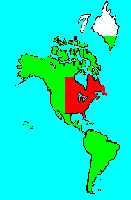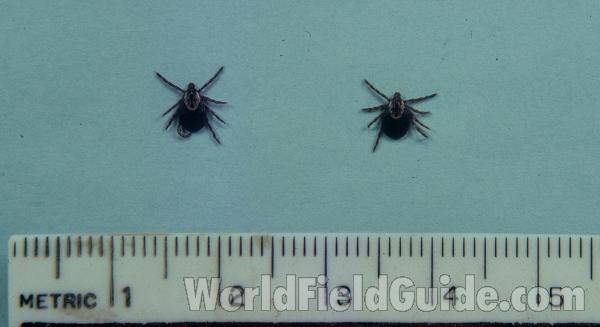SPECIES INFO
Wood Tick family (Ixodidae) is one of the two families called "hard ticks". (The other family is called Nutalliellidae). The "hard ticks" can be identified by the hard plate on the top side of the tick. Although as of l997, this group of ticks was not known to carry Lyme Disease, this family does carry other diseases such as Rocky Mountain Fever. Some of the common United States species are as follows:
Dermacentor andersoni - NW USA - Rky. Mnt. Spotted Fever Tick
Dermacentor albipictus - NY - Texas - Winter Horse Tick
Dermacentor halli
Dermacentor hunteri
Dermacentor occidentalis - Calif. - Pacific Tick
Dermacentor parumapertus
Dermacentor variabilis - E of Rockies - American Dog Tick
Ticks and Mites (Order Acarina) are a large order that has considerable economic importance to man. There are probably more than 30,000 species in this order. Included are several tick species that are known for transmitting serious diseases such as Rocky Mountain Fever and Lime Disease.
Arachnid (Class Arachnidae) consists of nine to eleven different surviving orders depending upon how one divides the Arachnid class. In total, there are about 100,000 to perhaps 105,000 species grouped in the following eleven orders:
Order - - - - - - - Number of Species
Acarina-Mites and Ticks - 30,000 to 48,000
Amblypygi-Tailless Whipscorpions - 60
Araneae-Spiders - 35,000 to 40,000 (2016)
Palpigrada-Micro Whipscorpions - 50
Ricinulei or Podogona-Ricinulids - 20
Pseudoscorpionida-False Scorpions - 1,000
Schizomida-Short Tailed Whipscorpions - --
Scorpionida-Scorpions - 2,000 to 1,286 (2016)
Solpugida-Sun Spiders, Windscorpions - 1,000
Phalangida-Daddy Long Legs-Opioiones- - 2,200 to 5,000 (2016)
Uropygi-Whipscorpions - 70 to 130 (2016)
The old order, Pedipalpida (Whipscorpions), has been divided into the following orders:
Uropygi - (Whipscorpions)
Ambylypygi - (Tailless Whipscorpions)
Schizomida - (Short Tailed Whipscorpions)
Jointed Legged Animals (Phylum Arthropoda) make up the largest phylum. There are probably more than one million different species of arthropods known to science. It is also the most successful animal phylum in terms of the total number of living organisms.
Butterflies, beetles, grasshoppers, various insects, spiders, and crabs are well-known arthropods.
The phylum is usually broken into the following five main classes:
Arachnida: - Spiders and Scorpions
Crustacea: - Crabs and Crayfish
Chilopoda: - Centipedes
Diplopoda: - Millipedes
Insecta: - Insects
There are several other "rare" classes in the arthropods that should be mentioned. A more formal list is as follows:
Sub Phylum Chelicerata
C. Arachnida: - Spiders and scorpions
C. Pycnogonida: - Sea spiders (500 species)
C. Merostomata: - Mostly fossil species
Sub Phylum Mandibulata
C. Crustacea: - Crabs and crayfish
Myriapod Group
C. Chilopoda: - Centipedes
C. Diplopoda: - Millipedes
C. Pauropoda: - Tiny millipede-like
C. Symphyla: - Garden centipedes
Insect Group
C. Insecta: - Insects
The above list does not include some extinct classes of Arthropods such as the Trilobites.
Animal Kingdom contains numerous organisms that feed on other animals or plants. Included in the animal kingdom are the lower marine invertebrates such as sponges and corals, the jointed legged animals such as insects and spiders, and the backboned animals such as fish, amphibians, reptiles, birds, and mammals.


